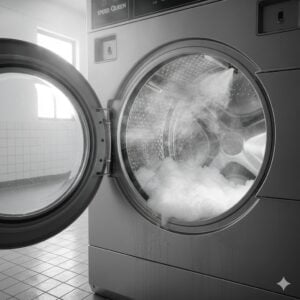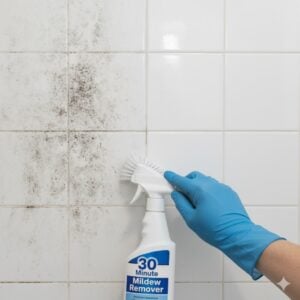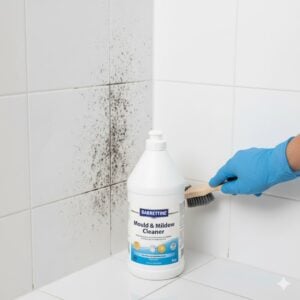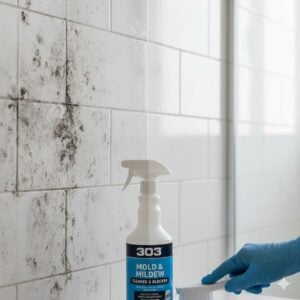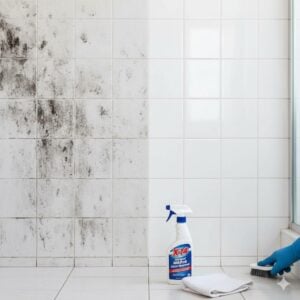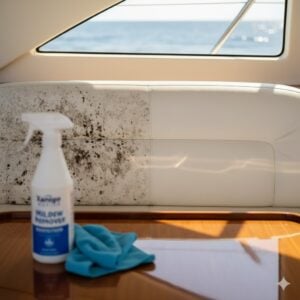Hello, dear readers! Battling against mold allergies in the UAE can feel like a relentless quest. Recognizing the discomfort and health risks associated with mold exposure is crucial. That’s why understanding how to tackle this issue head-on is vital for maintaining a healthy living environment. In this guide, we’re diving deep into strategies to eradicate mold allergies, ensuring your home is a safe haven from these unseen adversaries. Join us as we explore the top tips and tricks that have proven effective in keeping mold at bay and safeguarding your health.
Table of Contents
Toggle#1 Understanding Mold Allergy
Mold allergies can significantly impact your daily life, especially in climates like the UAE’s, where the combination of heat and humidity provides a fertile breeding ground for molds. These allergens are not just a mere inconvenience; they pose serious health risks, particularly to those with respiratory issues or weakened immune systems. Mold allergies occur when individuals inhale mold spores, leading to allergic reactions that can range from mild to severe. Symptoms often mimic those of other allergies, including sneezing, itching, runny nose, congestion, and dry skin. More severe reactions can include asthma attacks or difficulty breathing, highlighting the urgency of addressing mold problems promptly.
Understanding the enemy is the first step in combating mold allergies. Molds are fungi that thrive on moisture and can grow on almost any substance, as long as moisture, oxygen, and an organic source are present. Common indoor molds include Cladosporium, Penicillium, Alternaria, and Aspergillus. These molds disperse invisible spores into the air, which, when inhaled, trigger allergic reactions in sensitive individuals.
The prevalence of mold in homes is often underestimated. It can grow behind walls, under floors, or in other hidden areas, making it difficult to detect until it becomes a significant problem. Some signs that indicate the presence of mold include a musty smell, visible mold growth, water damage, or ongoing moisture issues like leaks or condensation. Residents experiencing unexplained allergies or respiratory issues should suspect mold as a possible cause.
For those susceptible to mold allergies, the presence of mold can dramatically affect their quality of life. It can disrupt sleep, reduce productivity, and even lead to more time off work or school due to health issues. Thus, identifying and mitigating mold exposure is critical. It involves not just cleaning up existing mold but also addressing the underlying moisture problems that allow mold to thrive.
In combating mold allergies, knowledge and vigilance are your best defenses. Regularly inspecting your home for signs of moisture and mold, promptly addressing any leaks or dampness, and maintaining good indoor air quality can help minimize your risk. For areas prone to mold growth, consider using a dehumidifier to keep humidity levels in check and ensure your living spaces remain healthy and comfortable.
#2 Identifying Mold in Your Home
Identifying mold in your home is a crucial step in safeguarding your health and ensuring a clean living environment. Mold can be stealthy, often growing in places you wouldn’t expect and without any visible signs until it’s too late. Knowing where to look and what to look for can help you catch a mold problem before it escalates.
Mold loves damp, dark, and humid places, making bathrooms, kitchens, basements, and areas around windows prime targets for growth. However, it’s not limited to these areas. Mold can also thrive under carpets, inside walls, in ceiling tiles, and around plumbing pipes, especially if there is any water damage or leaks. Visual inspection in these areas is key. Look for discoloration, warping, or a fuzzy growth on surfaces. Mold comes in a variety of colors, including black, white, green, or orange, making it sometimes difficult to distinguish from mere dirt or soot.
Another tell-tale sign is a musty, earthy smell, particularly in areas where moisture accumulates. This odor can often lead you to the source of mold growth, even if it’s not immediately visible. For hidden mold, pay attention to signs of water damage or moisture problems, such as peeling paint, water stains on walls or ceilings, and excessive condensation on windows.
Health symptoms can also be an indicator of mold presence. If you or family members experience sudden respiratory problems, such as sneezing, coughing, or asthma attacks, especially in certain areas of the home, mold might be the culprit.
For a thorough investigation, consider hiring professionals for a mold inspection, especially if you suspect hidden mold. They have the tools and expertise to uncover mold in places you might not think to look, ensuring no area goes unchecked.
Taking swift action at the first sign of mold can prevent it from becoming a larger issue. Regular cleaning, fixing leaks, and ensuring good ventilation are key steps in mold prevention. However, identifying the mold is the first step in addressing the problem.
#3 The Right Cleaning Solutions
Choosing the right cleaning solutions for mold removal is essential in ensuring the problem is effectively addressed without causing harm to your health or the environment. While there are numerous commercial products available, not all are created equal, and some home remedies can be surprisingly effective. The key is to select a solution that not only kills the mold but also prevents it from returning.
For non-porous surfaces, such as tiles, sinks, and glass, a solution of bleach and water can be effective. Mix one cup of bleach with a gallon of water and apply it to the moldy area, letting it sit for at least 10 minutes before rinsing thoroughly. This solution is powerful against mold, but it must be used with caution due to the harshness of bleach. Always wear gloves and ensure the area is well-ventilated.
For more delicate surfaces or if you prefer a less harsh method, vinegar can be a good alternative. White distilled vinegar, applied undiluted, has been shown to kill a significant percentage of mold spores. Spray the vinegar on the affected area, let it sit for an hour, and then wipe clean with water. The vinegar smell will dissipate after a few hours.
Another effective natural solution is hydrogen peroxide. A 3% solution of hydrogen peroxide applied to the moldy surface can kill mold effectively. Let it bubble for about 10 minutes before scrubbing and rinsing. Hydrogen peroxide is a safer alternative to bleach as it doesn’t produce harmful fumes and is not toxic.
Baking soda and water or a baking soda and vinegar mix can also be used for mold remediation. This is especially useful for absorbent or porous materials as it helps to deodorize as well as kill mold. Apply the mixture to the area, scrub, and then rinse or wipe clean.
For persistent mold problems or large areas, professional-grade products or the assistance of a mold remediation service may be necessary. These products are designed to penetrate deeper into surfaces and eradicate mold more effectively than some home remedies.
Regardless of the solution you choose, it’s crucial to address the root cause of the mold, such as leaks or high humidity, to prevent its return. Regular cleaning and maintenance of high-risk areas can help minimize the likelihood of mold growth.
#4 Professional Remediation vs. DIY
When facing a mold issue in your home, deciding between embarking on a DIY mold remediation project or hiring professional services is crucial. Each approach has its advantages and limitations, and understanding these can help you make an informed decision that ensures the health and safety of your household.
DIY Mold Remediation: For smaller mold problems, such as those covering less than 10 square feet, a DIY approach can be effective and cost-efficient. This might include areas like bathroom tile grout or small patches on walls. Using household cleaners, vinegar, or bleach solutions, as previously discussed, can be adequate for these minor issues. The advantage of DIY is the immediate action and cost savings. However, without the proper knowledge, tools, or safety equipment, you risk incomplete removal or exposure to mold spores, which can exacerbate health problems. Furthermore, without addressing the underlying moisture issue, mold is likely to return.
Professional Remediation Services: For extensive mold infestations, especially those involving porous materials or hidden mold within walls or under floors, professional remediation is recommended. Professionals are equipped with industrial-grade equipment, such as HEPA vacuums and air scrubbers, and have access to antimicrobial chemicals not available to the public. They possess the expertise to identify the full extent of the mold problem, including hidden areas you might overlook. Importantly, they also have the protective gear to safely remove mold without risk to themselves or your family. The primary drawback is the cost, which can be substantial depending on the extent of the infestation and the repairs needed.
Choosing between DIY and professional remediation depends on the mold’s scope, the project’s complexity, and your expertise and ability to safely handle the removal. For any mold remediation effort, safety should be the top priority. This means using appropriate protective gear, such as masks and gloves, and ensuring the area is well-ventilated. Regardless of the approach, addressing the source of moisture is critical to prevent mold from returning.
#5 Preventative Measures for Mold Growth
Preventative measures are the cornerstone of mold management, ensuring that the environment within your home does not become a hospitable refuge for mold growth. By focusing on controlling moisture levels, enhancing air circulation, and conducting regular inspections, you can significantly reduce the likelihood of mold taking hold.
- Control Humidity: The most critical step in preventing mold is to control indoor humidity levels. Ideally, keep indoor humidity below 60%, using dehumidifiers if necessary, especially in naturally humid areas like basements or bathrooms. Simple actions, such as using exhaust fans in bathrooms and kitchens, can also help reduce moisture levels in the air.
- Ensure Proper Ventilation: Good ventilation is essential in preventing mold growth. Ensure that your home’s ventilation systems are working correctly and that air can circulate freely throughout the house. Open windows when weather permits to allow fresh air in and use fans to enhance circulation, particularly in areas prone to moisture buildup.
- Fix Leaks Promptly: Water leaks provide the perfect breeding ground for mold. Regularly inspect your home for leaks in pipes, roofs, windows, and foundations, and repair them promptly. Even minor leaks can lead to significant mold problems if left unaddressed.
- Dry Wet Areas Immediately: Mold needs moisture to grow, so it’s essential to dry any wet areas immediately. This includes after spills, leaks, or floods. Materials like carpeting, bedding, or furniture that have been soaked should be dried within 24 to 48 hours to prevent mold growth.
- Use Mold-Resistant Products: When renovating or building, consider using mold-resistant products like mold-resistant drywall or mold inhibitors for paints. These products can be particularly useful in high-moisture areas such as bathrooms and kitchens.
- Regular Cleaning and Maintenance: Regular cleaning can help prevent mold by removing potential food sources for mold spores, such as dust and dirt. Pay special attention to bathrooms and kitchens, where mold is more likely to grow due to higher humidity and moisture levels.
- Inspect and Clean HVAC Systems: Your home’s heating, ventilation, and air conditioning (HVAC) systems can harbor mold and distribute spores throughout the house. Regular inspections and cleaning of these systems, including changing filters as recommended, can help prevent mold proliferation.
By integrating these preventative measures into your routine, you create an inhospitable environment for mold, safeguarding your home and health. It’s a proactive approach that not only addresses the symptoms of mold growth but also tackles the root causes, ensuring a healthier living space.
#6 The Role of Air Purifiers and Dehumidifiers
Incorporating air purifiers and dehumidifiers into your home environment can be a strategic move in the fight against mold allergies. These devices work by reducing the number of mold spores in the air and controlling humidity levels, respectively, both of which are crucial in preventing mold growth and mitigating allergy symptoms.
Air Purifiers: These devices are designed to filter the air, removing contaminants, including mold spores, pollen, dust, and other allergens. For maximum effectiveness against mold spores, look for air purifiers that feature HEPA (High-Efficiency Particulate Air) filters. HEPA filters can capture particles as small as 0.3 microns, which encompasses the size of most mold spores. Positioning air purifiers in areas most affected by mold or where you spend the most time can help reduce exposure to mold spores. Regular maintenance, such as filter replacement according to the manufacturer’s guidelines, is crucial to keep the device functioning effectively.
Dehumidifiers: These devices reduce humidity levels, making your home less hospitable to mold. By keeping indoor humidity below 60%, dehumidifiers can significantly retard mold growth. This is particularly important in areas of the home that are prone to dampness, such as basements, laundry rooms, and bathrooms. There are various types of dehumidifiers, including refrigerative and desiccant models, each suited for different environments and needs. Regular emptying of the water container and cleaning of the device are essential to ensure efficient operation.
It’s important to note that while air purifiers and dehumidifiers can aid in controlling mold and improving air quality, they are not a cure-all solution. These devices should be part of a comprehensive approach to mold prevention and remediation, which includes identifying and eliminating sources of moisture, proper ventilation, and regular cleaning.
When selecting air purifiers and dehumidifiers, consider the size of the space you need to treat, as devices come in various capacities. Additionally, energy efficiency, noise level, and ease of maintenance are important factors to keep in mind.
#7 Regular Home Maintenance Checks
Regular home maintenance checks are a pivotal strategy in preventing mold growth and ensuring the longevity and health of your living environment. These checks allow homeowners to identify and address potential issues before they escalate into serious mold problems. Here’s how to conduct effective maintenance checks:
- Inspect for Water Leaks: Regularly check under sinks, around toilets, and anywhere plumbing is present for signs of leaks or moisture. Don’t forget to inspect the exterior of your home for signs of water intrusion, such as damaged roofing or siding, which could lead to internal moisture problems.
- Check Ventilation Systems: Ensure that your home’s ventilation systems, including bathroom and kitchen exhaust fans, are functioning correctly. These systems help to remove excess moisture from the air, a key factor in preventing mold growth.
- Examine Windows and Doors: Look for condensation or signs of water penetration around windows and doors. Seals should be intact, and any damage that could allow moisture to enter needs to be promptly repaired.
- Evaluate the Roof and Gutters: A damaged roof or clogged gutters can lead to water accumulation and eventual leaks into your home, creating ideal conditions for mold growth. Inspect these areas regularly, especially after severe weather events.
- Monitor Humidity Levels: Use a hygrometer to monitor the humidity levels within your home, ensuring they remain below 60%. High humidity levels can encourage mold growth, even in the absence of obvious water leaks.
- Look for Visible Signs of Mold: In areas prone to moisture, keep an eye out for visible signs of mold. Early detection is key to preventing widespread mold issues.
- Assess Basements and Crawl Spaces: These areas are often out of sight and can be prone to moisture accumulation. Regular inspections can help identify any issues before they become major mold problems.
- Maintain Landscaping: Ensure the ground slopes away from your home’s foundation to prevent water from pooling around the base, which can lead to moisture problems indoors.
By incorporating these regular maintenance checks into your routine, you can significantly reduce the risk of mold growth in your home. Addressing potential issues early not only helps in mold prevention but can also save you time and money on costly repairs down the line.
Why Bio On is Your Go-To Solution for Mold Allergy
Bio On stands as a beacon for those grappling with mold issues, providing a blend of expertise and advanced technology in mold remediation and deep cleaning services. Specializing in eradicating mold from its roots and ensuring it doesn’t return, Bio On utilizes state-of-the-art equipment and techniques tailored to the unique climates of the UAE. The team comprises seasoned professionals who not only remove mold effectively but also address the underlying moisture problems, offering sustainable solutions. With a commitment to health and safety, Bio On ensures a thorough, hassle-free service, making it the go-to solution for creating healthier, mold-free living environments. For anyone facing mold challenges, Bio On offers the assurance of a comprehensive, effective approach to mold remediation.
Conclusion
In conclusion, tackling mold allergies requires a multifaceted approach, encompassing everything from identifying and removing mold to implementing preventative measures and utilizing air purifiers and dehumidifiers. Addressing mold issues not only improves the quality of your indoor environment but also protects your health. Understanding the nuances of mold remediation and prevention can seem daunting, but with the right guidance and expertise, it’s entirely manageable. For those seeking professional advice or mold remediation services, Bio On is equipped to offer comprehensive solutions. Don’t let mold compromise your living space or health; reach out to the Bio On team via the WhatsApp button for a free consultation and take the first step towards a mold-free home.







